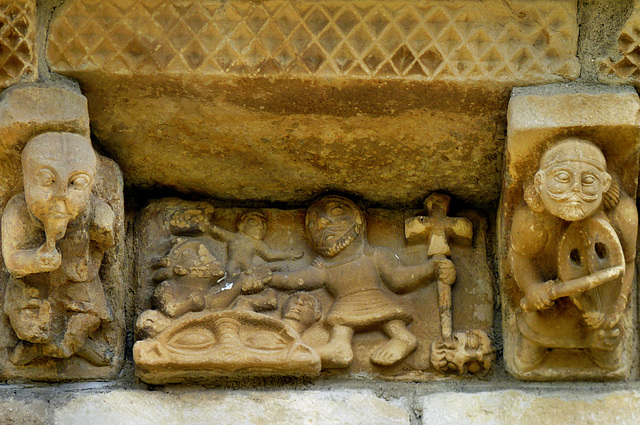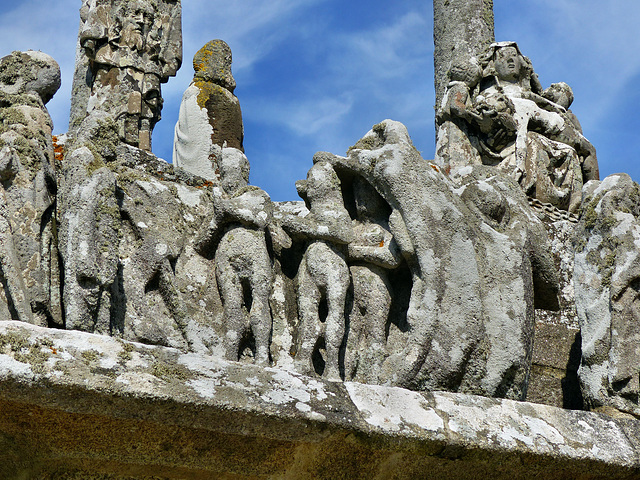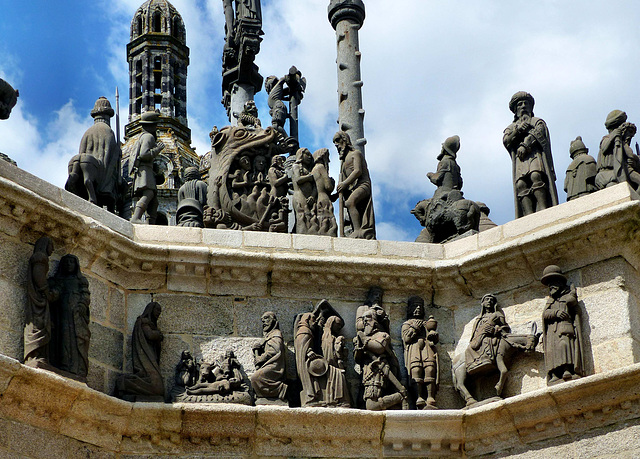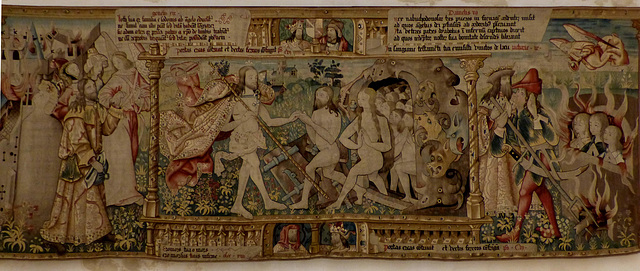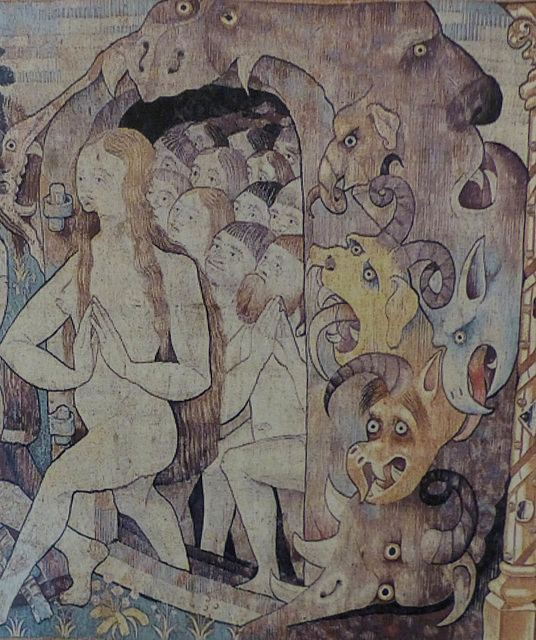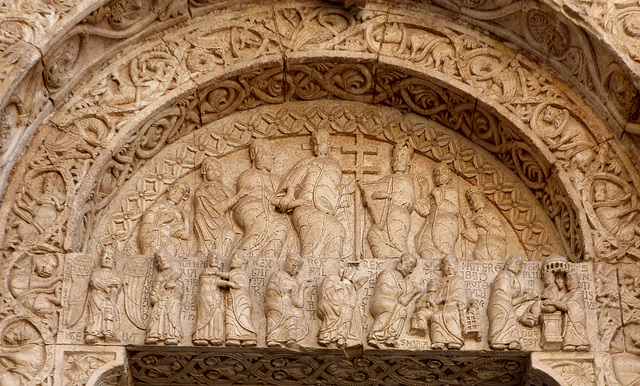
Harrowing of Hell
The descent of Christ into Hell refers to the period of time between the Crucifixion of Jesus and his resurrection. In descent, Christ brought salvation to the souls held captive there since the beginning of the world.
Estella - Iglesia de San Pedro de la Rúa
Estella was founded in 1090 by King Sancho Ramírez to encourage frankish merchants, to settle here and so support the pilgrims on their way to Santiago de Compostella. Recent excavations have proven, that early immigrants came from Le Puy ("Via Podensis") and Tour ("Via Turonensis").
The name "Estella" (= star) seems to be choosen by very experienced marketing specialists to start the business, as this refers to the Magi and as well to Charlemagne as he "saw in the heaven a pathway of stars" leading to Galicia (Pseudo Turpin).
Aymeric Picaud, author the Codex Calixtinus, praises the food here and even mentions the "healthy water". Estella thrived, in 1354 there were six hospitals of pilgrims here.
The "Iglesia de San Pedro de la Rúa" was mentioned already in 1174, in 1256 this was the largest church in Estella.
Attached to "San Pedro de la Rúa" is the cloister, just like the church it got erected within the 12th century. Two sides of the cloister survived the times, though some of the carvings are rather weathered.
The Harrowing of Hell
Jesus, holding a cross, welcomes Adam and Eve, who can leave the hell now. The poor souls on the right side must stay, while more sinners are thrown into hell from above.
Artaiz - San Martin
This church, dedicated to Saint Martin of Tours, was a real surprise to me. The single nave structure was probably erected within the 12th century. It was built in a "walking distance" off the pilgrim routes (like "San Pedro de Echano"), as the hamlet Artaiz is just about 10kms north of the "Camino Aragonés". San Martin will have been for sure a stopover for pilgrims, who had visited the tomb of Saint Martin of Tours, following the "Via Turonensis".
The masterly composed and carved portal of Saint Martin is extraordinary in the specific iconography, that in parts may reflect the relations to the Islamic neighbours (Reconquista). Here is a script by German arthistorian Hedda Finke about this subject.
art.unt.edu/medieval-symposium/presenter.php?year=2009&am...
Between the seven corbels under the portal´s roof are six reliefs.
This one depicts the "Harrowing of Hell".
In the time between Crucifixion and the Resurrection Christ (here without a nimbus!) descended into hell, bringing salvation to the righteous, who had died since the beginning (mostly symbolized by Adam and Eve). Here the giant mouth of the hell is open. Christ spears a beast with a cross, that reminds on a processional cross or a pilgrim's staff.
The corbels depict a flautist (left) and a musician with a vielle.
Chapelle Notre-Dame de Tronoën
Next to the Chapelle Notre-Dame de Tronoën is the large calvary, one of the landmarks of Brittany.
Erected 1450/1470, this is the oldest of the great calvaries in Brittany. The rectangular base measures 4,5m x 3,5m. Under the crucifiction are two friezes, depicting themes from the New Testament. There are lots of scenes and details.
Harrowing of Hell (aka "Descensus Christi ad Inferos"). Adam, Eve and the first of the "righteous men and women" can be seen, striding through the Hellmouth.
Codrongianos - Basilica di Saccargia
The "Basilica della Santissima Trinità di Saccargia" is probably the most important and renowned Romanesque church in the island of Sardinia.
The construction was commissioned by the "giudice" of Torres, a powerful judge. The church was completed and got consecrated in 1116. It was built, over the ruins of a pre-existing monastery, on the floorplan of a "Tau Cross" just like the neighbouring "San Michele di Salvenero".
An abbey was founded by Camaldolese monks. The order had been founded about 100 years earlier by Saint Romuald in Camaldoli (Tuscany).
The church was abandoned in the 16th century, the monastery fell in ruins, and only some walls and foundations can be seen. The church was restored and reopened in the 20th century.
The apse is covered with a large fresco, dated 1180-1200. Here is a detail. Seen left is the "Deposition of the Sepulcre", where of the Myrrhbearers only Virgin Mary has a nimbus. To the right the "Descent into Limbo". The devil is under Christ´s feet.
Souvigny - Prieuré Saint-Pierre-et-Saint-Paul
In 915 Aymar de Bourbon, ancestor of the House of Bourbon, gave land in Souvigny to the Cluny Abbey for the construction of a monastery. At that time the "Abbaye de Cluny" was just 5 years old, as it had been founded 910 by William I, Duke of Aquitaine, (aka "William the Pious").
Souvigny was one of the first priories, dependent from the Cluny Abbey, so it was known later as "one of the five eldest daughters of Cluny".
Cluny developed into the most powerful abbey in the Middle Ages, when the Cluniac Reforms changed the monastic life in Europe. German historian Dr. Joachim Wollasch ("Cluny, Licht der Welt"), estimates that in its haydays, more than 10.000 monks were parts of this network´, that stretched all over Europe. The pelerinage to Santiago de Compostella was one of the great "themes", developed and strongly supported by Cluny.
The priory in Souvigny, located about 130kms west of Cluny, was such an important convent, that two of the powerful abbots of Cluny, Majolus (+ 994) and Odilo (+ 1049) died here. Their graves were a place of pilgrimage site soon after. To cope with the growing number of pilgrims, the priory´s church got enlarged already within the 10th century.
Mayeul (= Majolus) was the 4th, Odilon (= Odilo) was the 5th abbot of the Abbey of Cluny. Odilo "invented" and established the "All Souls' Day" (2. November), that was adopted in the whole Western church.
The church, probably built after the model of Cluny III, with five aisles structure and two transepts, crumbled, when the times got tougher in the next centuries. A renovation was done in the 15th century, but the interior structure is still "clearly" Romanesque. It got recently renovated.
In 1793 French revolutionaries raged here with furor, destroyed the tombs and beheaded the sculptures, they believed to be connected to the Pope, Abbots or Bourbons.
They did not touch (most of) the capitals.
I´ll upload some fotos of the capitals of the transepts. These carvings differ in style and may be older, as the church was probably built from east (apse) to west (facade).
Christ (with a cross halo and a staff with a kind of procession cross) is in the center. The left side (compared to the right) is somehow chaotic. There are even two animals on the left.
This capital may (!) depict the "Harrowing of Hell".
In the time between Crucifixion and the Resurrection Christ descended into hell, bringing salvation to the righteous, who had died since the beginning. That would mean hell is left - heaven right.
Pleyben - Saint Germain
"Saint Germain" is in the center of the large "enclos paroissial".
The enclosure comprises of the parish church, the calvary and a funeral chapel/ ossuary.
The "Calvary on Pleyben" is the most massive calvary in Brittany. It was built in 1555 and at that time was attached to the narthex of the church. It was moved to this location in 1738. The calvary was constructed in the shape of a triumphal arch and has three crosses on it. It depicts 30 scenes from Christ´s life, staged on two levels.
To the very left Mary´s visit at Elizabeth (= the Visitation, Luke 1:39–56), the Nativity of Jesus, the Adoration of the Magi and (right) the Flight into Egypt. Seen above is Christ´s descent into hell (= "Harrowing of Hell").
La Chaise-Dieu
La Chaise-Dieu was founded in 1043 by Robert de Turlande. It was named "Casa Dei", from which La Chaise-Dieu developed. From the 11th to the 13th century, the abbey experienced rapid and significant development. When the founder died in 1067, already 300 monks lived here. In the Auvergne La Chaise-Dieu gained importance similar to that of the Burgundian Cluny Abbey. The abbey received many donations from noble families and administered 42 daughter monasteries. Popes who visited the abbey include Urban II, Calixt II, Alexander III. and Innocent II. In 1342, Pierre Roger, who had lived as a monk in La Chaise-Dieu, became Pope in Avignon under the name Clement VI. He financed a new building of the abbey church, in which he was finally buried. The building was completed in 1378 under the pontificate of Gregory XI, a nephew of Clement VI.
Since 1516 La Chaise-Dieu, like most other French abbeys, became "in commendam" so the commendatory abbot drew the revenue of the monastery but without fulfilling the duties of the abbot or even residing at the monastery.
Calvinist troops looted the abbey in August 1562. After most of the monastery buildings were destroyed by fire in 1695, they were rebuilt by the monks in the decades that followed. In 1786, Cardinal de Rohan, who was involved in the "Affair of the Diamond Necklace" was exiled to La Chaise-Dieu. While the abbey had 40 monks at that time, religious life ended at the beginning of the French Revolution.
La Chaise-Dieu is known for the tapestries, once woven to embellish the monks´ choir.
They were commissioned by Jacques de Saint-Nectaire and were woven by a Flemish workshop between 1501 and 1518.
The collection includes 14 tapestries of which two are different and may have been ordered by the abbot for his personal use.
The 12 other tapestries constitute a complete continuation of the Annunciation to the Last Judgment. An inventory prior to the Revolution mentions 18 tapestries, so four tapestries have therefore disappeared.
The tapestries were only exhibited during major liturgical feasts. They were rolled up and kept during the troubles during the Wars of Religion and the Revolution.
In 2013 the tapestries were removed. They got restored and returned to the abbey in July 2019. I was lucky to see them in August 2019.
Seen in the centre is "Harrowing of Hell". Note that part of the Hellmouth is an elephant. To the left is Loth and his family leaving Sodom, to the left Shadrach, Meshach and Abednego in the blazing furnace (Daniel 3.19)
La Chaise-Dieu
La Chaise-Dieu was founded in 1043 by Robert de Turlande. It was named "Casa Dei", from which La Chaise-Dieu developed. From the 11th to the 13th century, the abbey experienced rapid and significant development. When the founder died in 1067, already 300 monks lived here. In the Auvergne La Chaise-Dieu gained importance similar to that of the Burgundian Cluny Abbey. The abbey received many donations from noble families and administered 42 daughter monasteries. Popes who visited the abbey include Urban II, Calixt II, Alexander III. and Innocent II. In 1342, Pierre Roger, who had lived as a monk in La Chaise-Dieu, became Pope in Avignon under the name Clement VI. He financed a new building of the abbey church, in which he was finally buried. The building was completed in 1378 under the pontificate of Gregory XI, a nephew of Clement VI.
Since 1516 La Chaise-Dieu, like most other French abbeys, became "in commendam" so the commendatory abbot drew the revenue of the monastery but without fulfilling the duties of the abbot or even residing at the monastery.
Calvinist troops looted the abbey in August 1562. After most of the monastery buildings were destroyed by fire in 1695, they were rebuilt by the monks in the decades that followed. In 1786, Cardinal de Rohan, who was involved in the "Affair of the Diamond Necklace" was exiled to La Chaise-Dieu. While the abbey had 40 monks at that time, religious life ended at the beginning of the French Revolution.
La Chaise-Dieu is known for the tapestries, once woven to embellish the monks´ choir.
They were commissioned by Jacques de Saint-Nectaire and were woven by a Flemish workshop between 1501 and 1518.
The collection includes 14 tapestries of which two are different and may have been ordered by the abbot for his personal use.
The 12 other tapestries constitute a complete continuation of the Annunciation to the Last Judgment. An inventory prior to the Revolution mentions 18 tapestries, so four tapestries have therefore disappeared.
The tapestries were only exhibited during major liturgical feasts. They were rolled up and kept during the troubles during the Wars of Religion and the Revolution.
In 2013 the tapestries were removed. They got restored and returned to the abbey in July 2019. I was lucky to see them in August 2019.
The elephant is part of the Hellmouth (see prev. upload for a total).
Bitonto - Concattedrale di Bitonto
Bitonto, today a city of a population of about 55000, was probably founded by Greek settlers. Traces of a city wall dating to the 5th and 4th century BC were found. Legends tell that the name Bitonto is connected to an Illyrian king named Botone. Later "Civitas Butuntinenses" became a self-governing Roman municipium,
A Paleochristian basilica existed very early. During the 9th century, Bitonto successfully withstood a Saracen raid but got destroyed by Byzantine troops in 975. The Normans took over Apulia. In the 11th and 12th century. Under the rule of the Normans of Roger II of Sicily, William I of Sicily (aka William the Wicked) and William II of Sicily (aka William the Good), the city prospered and got new walls.
In 1227, Bitonto was the scene of ex-communication of Frederick II accused by pope Gregory IX of having come to terms with the sultan al-Malik al-Kamil.
-
The Bitonto Cathedral, dedicated to San Valentino, was erected 1175/1200 in the centre of the city. The construction was probably influenced by the "Basilica of San Nicola" in Bari and was done in the typical "Apulian Romanesque" style.
It is proven that the bishopric existed in 1089, though the crypt of the cathedral has remains of a 5th-century church.
There are three portals. The central one has wonderful tympanum, seen here. The lintel has the "Annunciation", the "Visitation", the "Adoration of the Magi" and the "Presentation in the Temple". Note that the Magi have their names written. The scene above is interpreted as an "Anastasia", the "Harrowing of Hell". Jesus descended to hell to bring salvation to all of the righteous who had died since the beginning of the world
Jump to top
RSS feed- Latest items - Subscribe to the latest items added to this album
- ipernity © 2007-2025
- Help & Contact
|
Club news
|
About ipernity
|
History |
ipernity Club & Prices |
Guide of good conduct
Donate | Group guidelines | Privacy policy | Terms of use | Statutes | In memoria -
Facebook
Twitter



